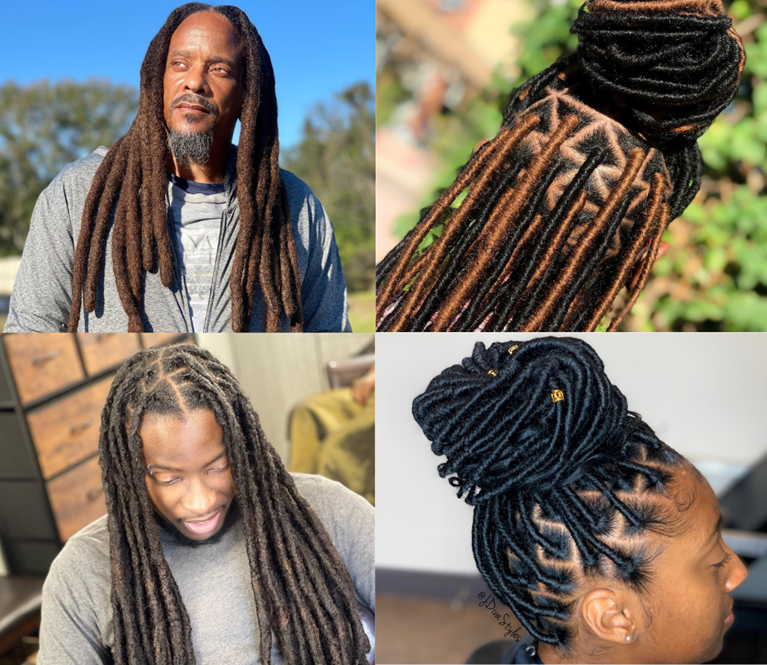
Locs is a natural hairstyle featuring twisted, coiled, or braided strands of hair that create a rope-like appearance and renowned for the ability to promote hair growth. For some, the term locs is used interchangeably with dreadlocks, but for others there is a distinction between the two. Understanding the difference between locs and dreadlocks requires an awareness of the cultural significance and history in which this style came to be. Originating as racial slur in slave history, dreadlocks was a derogatory term meaning ‘dreadful’ and was used to identify those with Rastafarian beliefs. From that, dreadlocks were normalized into a term symbolizing the Rastafarian lifestyle, culture and group of people, rather than solely a hairstyle.
In recent years, the term locs became popularized because it rejects the repressing history of dreadlocks and solely represents a group of hairstyles and techniques predominantly used on those with textured hair. Typically, Locs also have a more well-kept and tidier look, as they formed and maintained by tightly binding the hair strands through coiling, braiding, twisting or palm-rolling. Using these methods to enclose the hair in a loc creates a shielded barrier from external stressors, such as styling tools or harsh chemicals, which in turn prevents breakage and allows the hair to grow naturally.
The benefits of locs allow the natural hair to reach its maximum health and growth potential, making it the ideal choice for clients needing a versatile yet protective style. For stylists, knowing the difference in loc styles is crucial in helping meet their clients’ hair goals and concerns. And for their clients, having a stylist who understands various loc styles is just as important because it ensures clients can be met with realistic expectations, giving them the power to make an informed decision.
The seven styling foundations for most locs include traditional locs, sisterlocks, microlocs, freeform locs, semi-freeform locs, faux locs and wicks. Each clients’ hair texture, length and lifestyle may influence the choice of loc style and be based on the five growth stages: starter, budding, teen, mature and rooted. Read on to learn how each loc style can best suit your individual clients’ hair goals and concerns.
1. Traditional Locs

Source: Courtesy of @essenceofjillizm
Traditional locs are a medium to large loc type with a diameter of 5-14 mm that are typically no bigger than a medium-size box braid. This style is ideal for clients with coarse or tightly coiled and curly hair, wanting a low maintenance style with few reoccurring visits to the salon. Traditional locs require regular washing with residue-free shampoo, moisturizing with oil, and locking gel for retightening new growth when needed.
2. Sisterlocks

Source: Courtesy of @gserenebeuaty_
Sisterlocks are one of the smallest loc types with a diameter of 2-3 mm created by using a symmetrical grid pattern and interlocking tool for a more uniformed look—think a loc version of microbraids This style is suitable for all hair types, and especially for clients with fine hair or very tight coils. To maintain the grid pattern, clients need regular appointments every four to six weeks for retightening. Clients should use a gentle shampoo, oil or spray for moisturizing and locking gel for retightening.
3. Microlocs

Source: Courtesy of @gserenebeuaty_
Microlocs are a small loc type, sized in-between sisterlocks and traditional locs, where the tiny, individual locs resemble loose hair. Unlike sisterlocks, microlocs are less uniformed and created with any grid pattern or technique such as braiding, twisting or palm-rolling. This style varies in length and is ideal for clients with fine hair. Maintenance involves regular retightening every four to six weeks and requires clarifying shampoo, a lightweight moisturizer, and locking gel for retightening.
4. Freeform Locs

Source: Courtesy of @essenceofjillizm
Freeform locs are a large loc type usually with a diameter starting around 15 mm. They develop without parting and grow from the natural matting of hair without intervention or styling. They differ from traditional locs as they don’t require re-twisting new growth, making them the lowest maintenance loc style. The only maintenance required is regular washing with residue-free shampoo, moisturizing with oil, and separating any conjoined locs. Freeform locs are suitable for clients with all hair types.
5. Semi-Freeform Locs

Source: Courtesy of @essenceofjillizm
Semi-freeform locs are a medium-large loc type with a diameter of 5-14 mm. They’re a combination of freeform locs and traditional locs where some sections are allowed to form naturally while others are intentionally shaped and styled. Over time, the loc wearer opts to retwist less often, allowing the hair to grow out in potentially thicker locs. Clients should use a residue-free shampoo, oil for moisturizing and locking gel for shaping.
6. Faux Locs

Source: Courtesy of @jdivastyles
Faux locs are temporary loc extensions created by wrapping synthetic hair around a client’s natural hair. This style is suitable for all hair types, especially those with shorter or fine hair, and gives more versatility to clients looking for various lengths, thickness and color. Faux locs are a higher maintenance style, requiring regular touch-ups every six to twelve weeks. Clients should use residue-free shampoo, a lightweight moisturizer, and locking gel for retouching.
7. Wicks

Source: Courtesy of @essenceofjillizm
Wick locs are a large loc type with a diameter typically starting around 2-5 inches. They are a cylinder-shaped loc formed exclusively with a crocheting technique. This crocheting technique causes less damage to the natural hair than traditional locs but requires more maintenance and touch-ups every two months. Wicks are not a freeform loc and develop in three ways: by combining existing locs, by extensions or by the rubber bands method.

